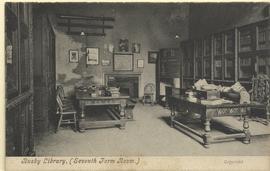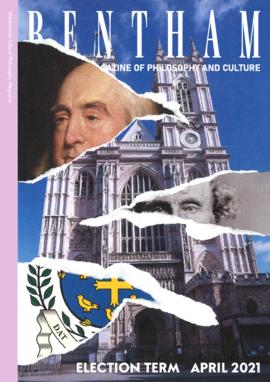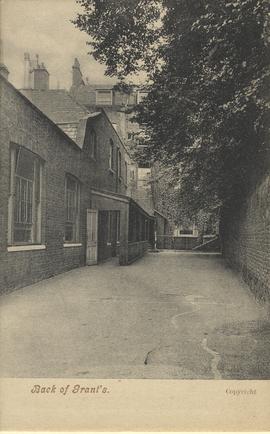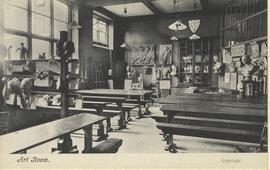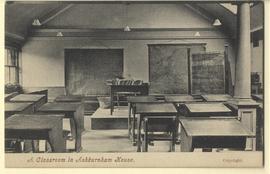One copy annotated on reverse by R.S. Chalk, as follows:
'Memories (R.S.C.) 1922-1924
I sat in Busby Library as a member of VII for 6 Terms ; from Play 1922 to Election 1923 my seat was in the far left-hand corner of this picture (a privilege to have chairs, no longer desks or forms!); from Play 1923-Election 1924 as First Classic (a little revived at that time) I chose a Chair at the end of the table by the window (we chose in order of seniority).
We sat at the feet of I.F. Smedley (never ‘Snogger’ to his Form), a profound Classical Scholar, complete master of his subject, and a gentleman. He had (I believe) been Master of the VII since 1898. He was also a consummate master of English and a purist (Eg.- ‘Baptized’ not ‘baptised’, because derived from Greek root; conversely, ‘Authorised’, never ‘authorized’). We were taken in some subjects by the HM –not so great a scholar, but with the priceless gifts of enthusiasm, zest and appreciation.
Our order for 1923-4 was determined by the result of Higher Cert. in July 1923. There were no promotions from CVI in 1923 so 13 of us continued for a second year in VII. Not caring to risk Election, 4-5 of us gained Open Scholarships.'
One copy annotated on reverse by R.S. Chalk, as follows:
'Back of Grant’s 1918-24
A portion of the School precincts I naturally never once set eyes on during all those years. Except for Monitors (on official duty) no member of any one of the five Houses was allowed to set foot inside another.
This no doubt Grant’s Yard (somewhat more specious than its counterpart up RR next door). The windows are protected by wire-mesh because of the ‘Yard Game’ played there, the counterpart of RR Yard Game. This was a kind of miniature football played four-or-five-a side with a rubber ball about 4 inches in diameter. A very fast game (and too rough for me personally). If the ball was ‘popped’ on an iron spike or (more likely) ‘skied’ into GG Yard next door, it meant an outlay of 6d, on another, if available. We would call, “Thank-you ball Grant’s!!” Sometimes our ball would come back, but not often. (GG balls were never skied into RR Yard!)'
One copy annotated on reverse by R.S. Chalk, as follows:
'1918-1920
The Art Room cannot but evoke memories of that peppery Manxman WILLIAM KNEEN who presided there from 1884 till just before his death in 1921. He was regarded not without reason as the most peculiar member of the staff. His diction (much imitated!) was extraordinary, e.g. ‘Will you give me at-tenshon?’ or (by way of punishment) ‘Take a Drill-ah! Take a Drill!’ His methods of teaching would be considered outmoded now – Finding the “common venishing point”, making drawings of the numerous classical plaster casts and (for Prep) time and again “Plen and Ele-vashon”. (Williamson who succeeded him belonged to the then Modern School and revolutionised things).
Wm. Kneen only taught the Under School and was a real friends to any who (like myself) loved Art. He died much lamented.'
His life as a pupil at Westminster. Cliques and the effect of the arrival of girls in sixth form. [4.09] Stayed in touch with surprisingly few Westminster schoolmates. [6.21] Phab [experience week in partnership with a charity working with disabled and non-disabled children]. How it has changed over the years. His work gave it more stability, health and safety clearance and financial stability. [10.54] Phab’s expansion over the years, and possible reasons for its growth. [13.54] Difference between his school days and time as a teacher. School now seems better able to help pupils who are less academically gifted than the others. School takes part in more outreach and charity work. School facilities much better. The Manoukian Music Centre, Millicent Fawcett Hall [theatre], Weston’s [classrooms] and Lawrence Hall [sports centre] were all acquired after his schooldays. [16.20] Difficult to tell if there’s been a change in ethos. Still promotes individuality. [18.07] Effects of internet. [19.25] Effects of increased numbers of pupils. [21.28] How his experience of the school has changed now he’s a teacher. [23.06] Will miss colleagues and pupils, but not the physical place. [26.12] His future plans. His move to the London Academy of Excellence. Potential to make a difference to social mobility. How he will interpret the role. [31.11] Proud moments as a pupil. [33.22] Proud moments as a teacher. The changed atmosphere in Ashburnham. The house publication The Ash Tree and house concerts and plays. The house has become a community. Has enjoyed his time as a teacher.
One copy annotated on reverse by R.S. Chalk, as follows:
'1918-1924
This would be the ante-room at the Head of Ashburnham Staircase (see L.E. Tanner, p20). The busts are those of Southey and W. Hastings, with the H.M’s chair. About 1922 (under A.T. Willett) this was converted to a Chess Room, the strict rule of silence up Lib being waived to allow the call “Check!”
In the ‘Novel Room’ adjoining were displayed various items presented to the School (see L.E.T. pp22-3). There come to mind the rudder of the VIII of 1845, the trireme cast, the bust of Sir Fras. Burdett. Also (not listed by L.E.T.) a block of (?) quartz from Ammon inscribed:- ‘OI ΠAYΛOY M’EΔOΣAN TOIΣ ΠETPAIOIΣI ΛIΘOYPΓOIΣ / ΠPIN ΔIOΣ AMMWNOΣ KEIMENON EN ΘEMEΘΛOIΣ’ (I once met an Old Pauline who explained its origin.) Similar blocks were presented to the Freemasons of five other Public Schools.'
One copy annotated on reverse by R.S. Chalk, as follows:
'This picture (well before my time) has its use in supplying a general date for this series of P.C.s (recorded in Record of OWW Vol III, under ‘Arthur Brown’ on p443 as “about 1911”).
It is always a source of regret that it was never my lot as a KS to take part in our supreme privilege of all - being first in the Empire to proclaim the Sovereign at a Coronation.
The only royal occasions in which I was able to take part were (1) Princess Mary’s Wedding in 1922 as a (very nominal) Steward at the North Door and (2) the Installation of the Knight’s of the Bath in 1923 or 1924. At this my companion and myself were Stewards with the task of checking tickets at the little North Aisle door, commonly called ‘Devil’s Door’. L.E. Tanner, in charge, posted us with the words “Now come along, you two Devils!”'
One copy annotated on reverse by R.S. Chalk, as follows:
'Memories, 1920-1924
After the cramped conditions prevailing in Rigaud’s Little Dorm, it was a joy to have a ‘House’ of my own, even as a Junior. It provided space, comfort and a welcome degree of privacy.
Pasted up in each House were “The Ten Rules of College”- the Magna Carta of Under Elections. I still remember: “Punishment to be by tanning or [for Upper Elections] desking, and in no other way”, and “No servants’ work to be done by any Under Election”. (There were of course two College Johns- and the ‘Nymphs’).
Each House was screened by a red-baize curtain. At ‘Lights Out’ (9:30) Mon. Chaun. and his partner pulled this back (rather farcically!) to make sure all Under Elections were in bed (of course his coming could be nicely timed!). The commonest occasion for a ‘Case’ was to be out of one’s House (even by an inch) after that.
In this picture, note (a) the hat-box, (b) school photos, no doubt purchased from John Brown.
It may also be noted that the ‘floreat’ (i.e. chamber-utensil) has been removed out of sight. This was called “Setting to Rights” and was regularly ordered on Play Nights, to avoid shocking curious guests who peered inside Houses!'
One copy annotated on reverse by R.S. Chalk, as follows:
'Class Rooms up Ashburnham were of course not originally designed for the purpose. As such they would have given a present-day Minister of Education a heart-attack, and certainly have been deemed unworthy of any Comprehensive or even County Primary School. However, we had no complaints - except about that ultra-gloomy room, on the ground floor (facing out on to Ashburnham Green) where the ferocious and austere E.L. Fox ruled the Upper Fifth with his rod of iron.
As far as I remember, the Class Room depicted was not a (Upper and Lower School, independent of Forms) Form Room, but was used for Sets, till these were discontinued after the arrival of Costley White.
Here in 1918-19 I learnt French under the acidulous W.N. Just and Maths under the doddering Rev. H. Hancock. (Both were ageing men, recalled as temporary members of the Staff to hold the fort while younger Masters were absent on War Service).'
